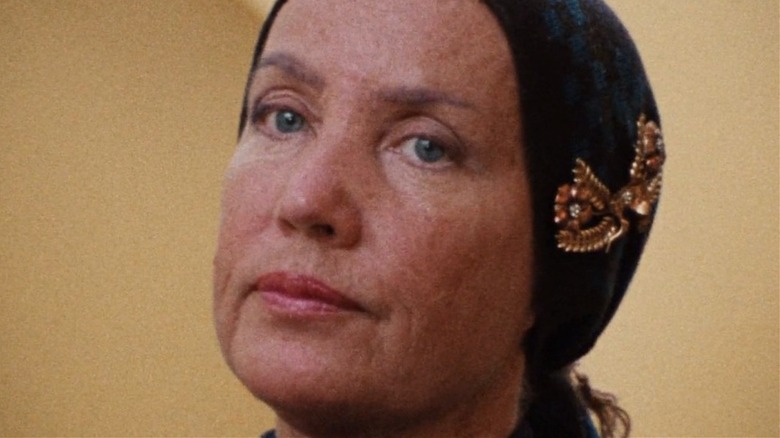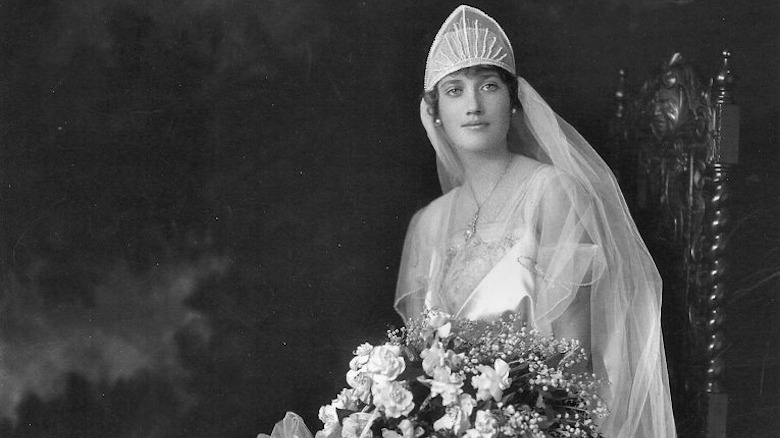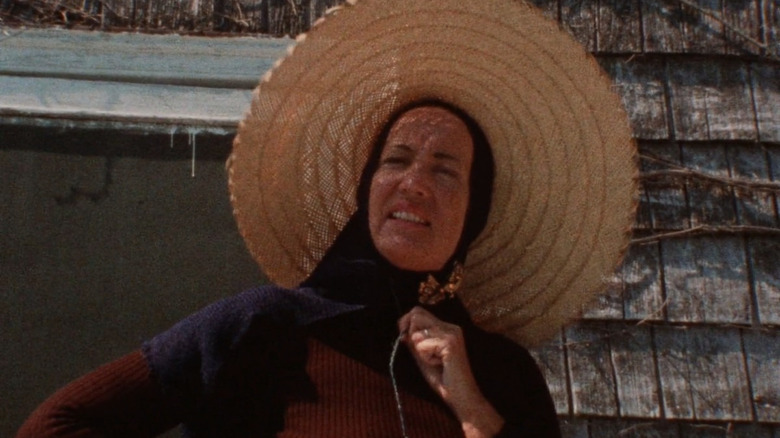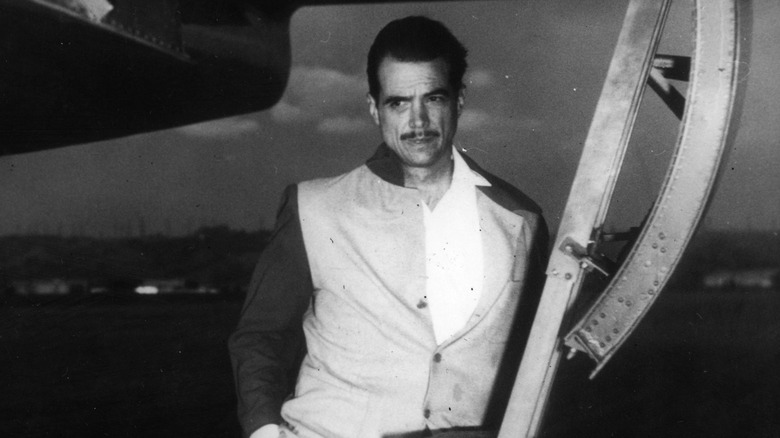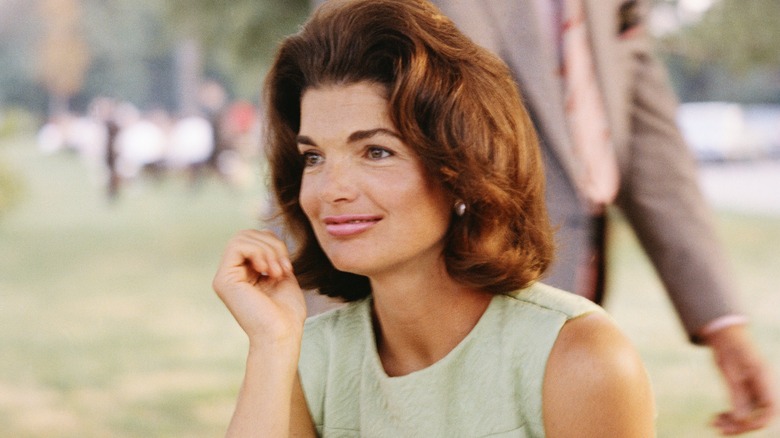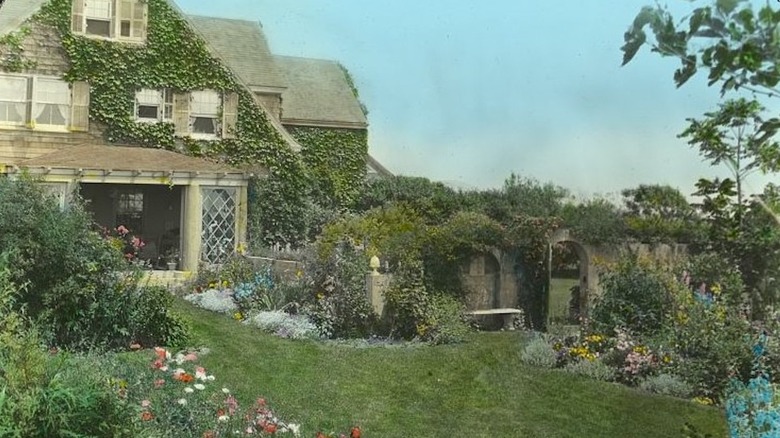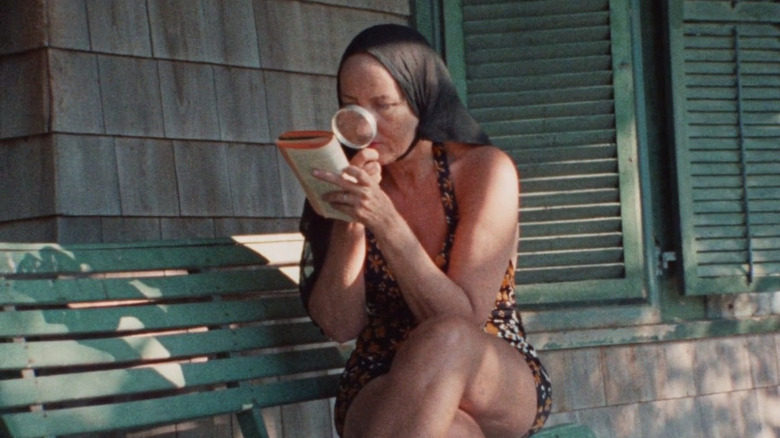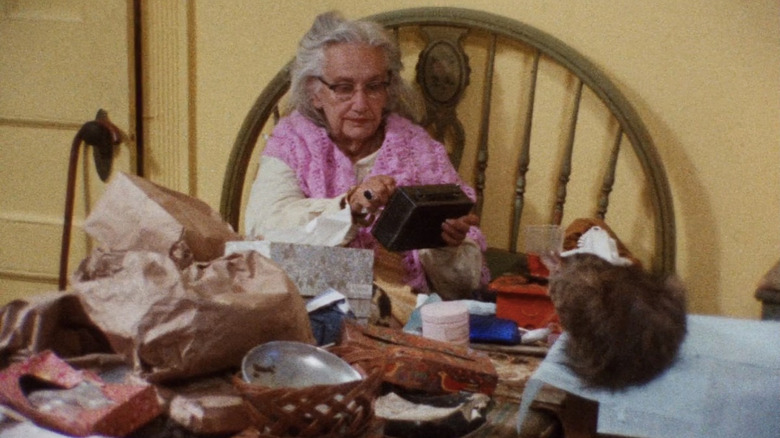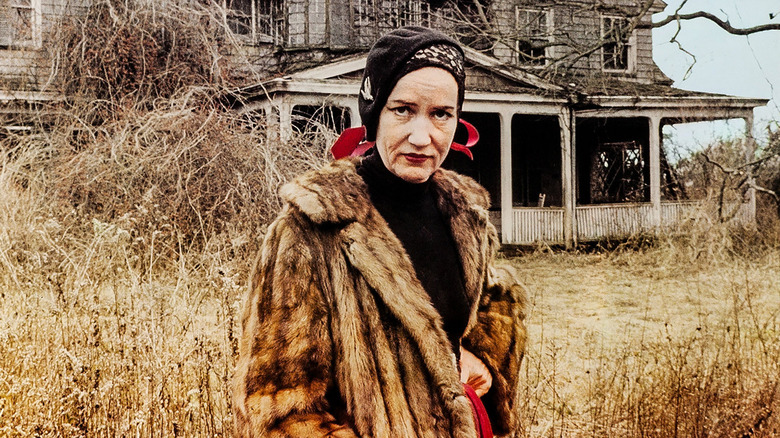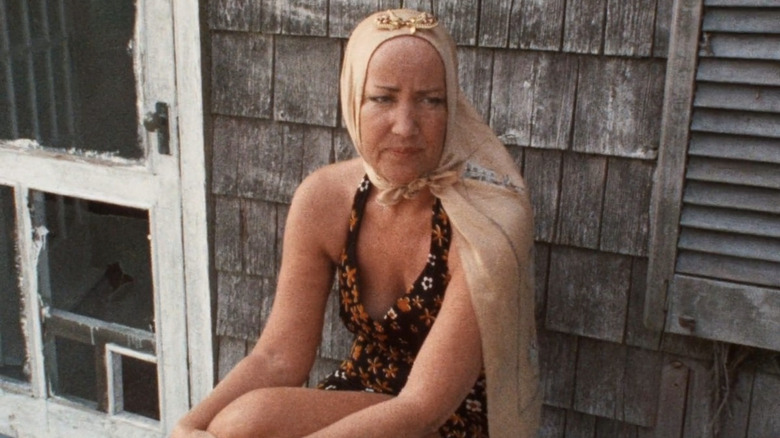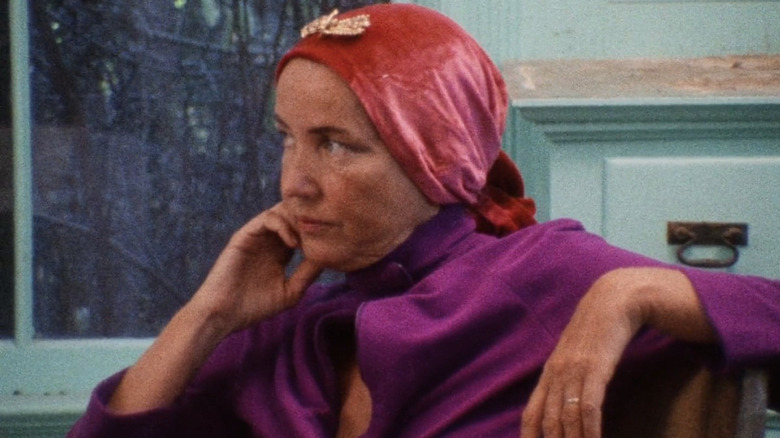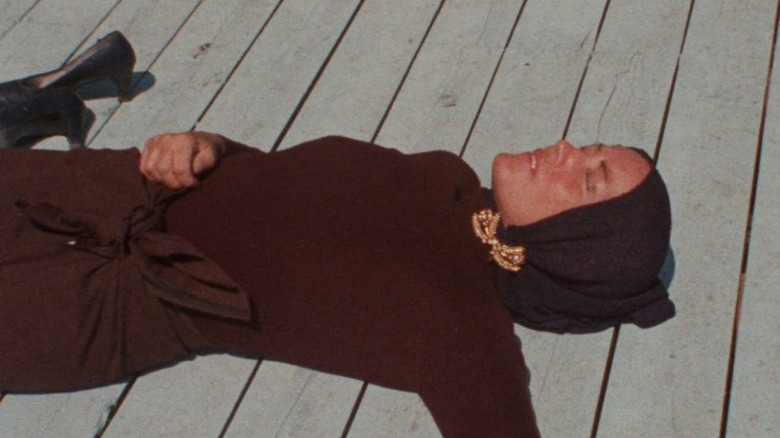Edith Bouvier Beale: The Eccentric Life Of Jackie Kennedy Onassis' Cousin
Jacqueline Kennedy Onassis needs no introduction. The former first lady is a celebrated icon in American history, and yet, Onassis' life in the spotlight also came with immense tragedy. According to The Washington Post, after the horrific assassination of her husband, John F. Kennedy, it's said that Onassis never spoke to the public about him again — but that's not the only family member she kept mum about throughout her life. Many people don't know that Onassis actually had a cousin who was once a socialite in her own right: Edith Bouvier Beale.
Beale was born on November 7, 1917, in New York, the eldest of three children (via Biography). Her early years saw her living between Manhattan and the Hamptons, enjoying her high-society upbringing. What's interesting about Beale is the swift turn her life took as an adult, when she lived as a recluse, looked after her mother, and completely forwent her childhood aspirations for A-list success. Eventually overshadowed by her cousin's immense fame, Beale was forgotten by the public — until the documentary about her life, "Grey Gardens," was released in 1975 (pictured).
"These two women were artists who were denied the opportunity to express their artistic impulse because of their position in society," explained Tony Maietta, co-author of the biography "The Marble Faun of Grey Gardens," to Fox News. "But the amazing thing [about Beale] is that she remained true to herself." Let's dive into Beale's eccentric life and how she eventually found the fame she deserved.
Edith Bouvier Beale's family history
Born in New York City in 1917, Edith Bouvier Beale (known as "Little Edie"), only knew wealth in the early years of her life. According to The New York Times, the socialite's father, Phelan Beale, was a Wall Street lawyer, while her mother, Edith Ewing Beale (pictured), a.k.a. "Big Edie," came from money herself as the daughter of a rich judge. However, as House Beautiful reveals, there is some confusion as to how Big Edie's family accumulated their wealth, as her father had a reputation for boasting that their family tree came from French nobles — an unsubstantiated claim.
Nevertheless, Big Edie's family pushed her to marry as early as possible, and in 1917, when she was 22, she married the 36-year-old Phelan. The pair moved to an Upper East Side apartment decked out with staff and personal chauffeurs and began having children, with Little Edie the first of the three.
By 1923, the family purchased their Grey Gardens property in East Hampton, and both Big Edie and her daughter loved their newfound freedom, spending their summers and holidays relaxing on the estate. Unfortunately, as House Beautiful notes, Phelan grew uneasy by his wife's new, laissez-faire attitude she adopted while staying at the sprawling mansion. By the mid-1930s, he left his family for a younger bride, leaving Big Edie with child support and Grey Gardens, per Biography.
She was a model and aspiring actor in her youth
As a child, Edith Bouvier Beale grew up with A-list aspirations. As revealed by House Beautiful, much like her mother, Little Edie had a talent for literature, acting, and performing. Biography notes that at the age of nine, one of her poems was published in New York Magazine. This success, along with regularly going to the theater and cinema with her mom, only fueled her desire for fame.
As she grew older, Beale also tried her hand at dancing, and as she dished to a New York Magazine reporter in 1972, she started her ballet training in her teens, followed by interpretive dance. The teenage Beale is said to have been a striking beauty, per Biography, and in 1934, she landed a modeling opportunity with Macy's, eventually earning her the nickname "Body Beautiful." Per The Vintage News, the socialite also claimed that she allegedly got offers from production companies Paramount and MGM during this time, yet why she didn't pursue acting right then remains a mystery.
Sadly, it would take years for Beale to reach the level of stardom she so craved as a child, only finding that level of fame after the release of the shocking 1975 documentary about her and her mother, "Grey Gardens" (via Biography). Nevertheless, the socialite always maintained her sense of pride. "I hate it when people say I was beautiful in the old days," she declared to New York Magazine at age 55, adding, "I like to think ... I'm terrific now!"
Edith Bouvier Beale had some alleged big-name trysts
During her years spent schmoozing with Manhattan's elite, it's believed that Edith Bouvier Beale was involved with some pretty big names. According to The Vintage News, J. Paul Getty allegedly proposed to Little Edie, and she was reportedly engaged to Joe Kennedy Jr. at another time, too. "I met Joe Jr. at a Princeton dance, and oh my!," Beale gushed to New York Magazine in 1972. "Joe was the most wonderful person in the world. There will never be another man like him."
Along with Getty and Kennedy, Biography reveals that the socialite also dated business magnate and acclaimed film director Howard Hughes. While Beale herself has remained mum on many of these supposed trysts, she did deny one rumor that circulated. As she told New York Magazine, during her years studying ballet and interpretive dance, the public thought she had eloped with "King Kong" star Bruce Cabot. "I didn't even know him," she declared, noting that all she ever did was flirt — something that probably caused many of these high-profile rumors.
Of course, without any confirmed sightings of Beale and these men documented in the press, take these tales with a grain of salt. "She was a great storyteller," recalled Lee Schrager, a friend of the starlet and founder of the South Beach and New York City Wine and Food Festival, to Town & Country magazine. "One of my favorite stories that I've got was her telling me that Aristotle Onassis was going to leave Jackie for her," he mused.
Did Edith Bouvier Beale and Jackie Kennedy Onassis get along?
Edith Bouvier Beale was Jackie Kennedy Onassis's older cousin, 12 years her senior. There are very few sources available to reveal whether or not the two women got along as children, but after Beale's father purchased the sprawling Grey Gardens property in the '20s, it's believed that both Little Edie and Onassis vacationed there in their youth (via The Vintage News).
Perhaps it's due to the significant age gap, but Beale and Onassis were never that close growing up — although that's not to say that the elder cousin didn't garner some respect in their earlier years. "There was a time when she was [Jackie's] highly successful older cousin," notes Muffie Meyer, the co-director of the Beale documentary, "Grey Gardens," to Town & Country. Yet, after Onassis became the first lady, Beale was suddenly left forgotten by the public, and as Meyer reveals, "I always had the feeling that Little Edie had a little bit of jealousy about that."
Nevertheless, in the later years of her life, Beale still spoke highly of her beloved cousin. During a chat with a reporter for New York Magazine in the early '70s, Little Edie praised Onassis and her husband, declaring, "They brought such art to the country!" After the success of "Grey Gardens," Beale eventually returned to New York for a brief stint, enjoying her newfound A-list fame. According to Town & Country, her younger cousin occasionally visited her during this time, scolding Beale for her public antics.
The history behind her family mansion, Grey Gardens
For better or worse, Edith Bouvier Beale and her mother, Edith Ewing Bouvier Beale, will forever be associated with their Hamptons mansion, Grey Gardens. According to House Beautiful, the elegant, 6,652-square-foot property was built in the early 1900s and occupied by two different families before the Beale purchase in 1923. It's said that Big Edie was immediately drawn to the estate, as it gave the former singer a more easygoing lifestyle than the high society living she inhabited in New York.
Sadly, Big Edie's new way of living was too much for her husband, and the pair separated in the early 1930s. Big Edie got to keep Grey Gardens in the divorce. Although the Great Depression was well underway, the socialite could still keep an entire staff at the property, including housekeepers, a cook, a chauffeur, and a governess. As detailed by New York Magazine, this dark economic time did little to impact Big Edie, as her father, Major Bouvier, was giving her an allowance of $3,500 a year, which led to a cushy lifestyle until he died in 1948.
As for Little Edie, in the early 1930s, her mother sent her to a finishing school in Connecticut. After graduating, she lived in Manhattan and remained there throughout the '40s, visiting her mother in Grey Gardens on occasion (via House Beautiful). Only after the early 1950s and Major Bouvier's death was Little Edie forced to head to Grey Gardens, after realizing her mother couldn't keep supporting her flamboyant lifestyle anymore.
She lived a reclusive life with her mother for 25 years
Edith Bouvier Beale's life took a devastating turn in 1952 when she was forced to give up her dreams of A-list success. Per House Beautiful, a Broadway producer invited the 35-year-old socialite to audition for a role that year. Yet, due to her mother's dwindling funds and mental state, Little Edie never got a chance to try out for the part, and instead, traded New York City for the Hamptons, where she would remain at Grey Gardens for over two decades.
After Little Edie's arrival, she and her mother quickly realized they had no money. According to The Vintage News, after the death of Edith Ewing Bouvier Beale's father, he left her $65,000 in trust. But as Little Edie would later allege, Jackie Kennedy's father — her uncle — took all the money for his daughters, leaving Big Edie with only $300 a month. Desperate, the Beales began selling all their Tiffany silver. The duo remained afloat until the 1960s with the help of Tom Logan, the caretaker of their property. Sadly, after he died in 1964, Grey Gardens fell into a state of absolute disarray, and with a subsequent burglary affecting Big Edie's mental state, the women began living a reclusive life.
When a New York Magazine journalist asked Little Edie about her life in Grey Gardens in 1972, the former socialite's answer was cutting. "Shall I tell you what I've done for 20 years? Fed cats." She then declared, "Nothing has happened in 20 years."
An inspection of Grey Gardens resulted in a scandal
By the early 1960s, Edith Bouvier Beale's life in Grey Gardens was far from the beautiful, gothic mansion she once spent her summers at. According to The New York Times, the abode was filled with countless cats, raccoons, and opossums, while 25 out of the 28 rooms weren't accessible at all. Things began to deteriorate after the death of Beale's caretaker in 1963, only furthered by a robbery that happened five years later, per The Vintage News.
In 1971, the press had a field day with the Hamptons estate after the Suffolk County Health Department went to Grey Gardens and discovered the horrific state it was in, including an absolute mountain of empty cans stacked in the dining room and human waste in the bedrooms. "Cats don't fit into having a house redecorated," declared Beale in a 1972 documentary, "That Summer," which was scrapped and eventually released decades later (via The Guardian). As detailed in The New York Times, Health Department officials threatened to evict the socialite and her aging mother unless they took care of the squalor they were living in, causing former-First Lady Jackie Kennedy to step in and help pay for the mansion's cleaning — a costly $32,000, per The Vintage News.
A few years later, during the filming of the "Grey Gardens" doc by Albert and David Maysles, Beale angrily remarked, "[The Health Department does] it to everybody. They want everybody to be the same. You can't have anything different" (via New Yorker).
The documentary about her life was an incredible success
In 1973, Jerry Torre met Edith Bouvier Beale and her mother at Grey Gardens for the first time. In an interview with Fox News, he shared that he had become a handyman for the property, later using his experience for a memoir that he published, "The Marble Faun of Grey Gardens." Speaking with the publication, he shared his insider look at the property during the '70s. "You could hardly see the mansion. It was overgrown with everything everywhere ... It was terrifying as well as fascinating."
The state of Grey Gardens made for an interesting (albeit somewhat exploitative) idea for a documentary — something that Albert and David Maysles capitalized on with the release of "Grey Gardens" in 1975. According to The New York Times, because of the horrendous state of the property and fleas that filled the room, the directors had to wear flea collars around their ankles while they shot some unbelievable footage, such as cats relieving themselves on once-expensive artwork while Beale and her mother merely cackled.
"Grey Gardens" was a hit upon its release, resulting in a Tony-winning Broadway musical, sampled by musicians such as the Stars and Rufus Wainwright, countless items of memorabilia, and eventually an HBO movie based on the doc starring Drew Barrymore and Jessica Lange (via CBC). What's more, as House Beautiful notes, because of the way "Grey Gardens" was shot — simplistically and without a score or voiceover narration — the voyeuristic air makes it widely considered the forerunner for reality TV.
She decided to sell Grey Gardens after her mother died
Edith Bouvier Beale and her mother, Edith Ewing Bouvier Beale, allegedly loved the documentary about their lives, "Grey Gardens." As revealed by The Vintage News, both women received $5,000 each for their involvement — no doubt enough to keep them afloat for a while after filming was completed.
Sadly, two years after the release of "Grey Gardens," Big Edie died, leaving her daughter with the crumbling property (via Town & Country). Beale decided she would finally sell the estate, spending the next two years looking for a buyer. According to "The Georgetown Ladies' Social Club," the former socialite tried selling the property to her famous cousin, Jackie Kennedy Onassis (who, at this point, was married to Aristotle Onassis). "My impoverishment ... became a vast public relations problem for Jackie," Beale recalled, adding, "She wanted nothing to do with it."
With her cousin out of the picture, Beale set out to look for a buyer that wouldn't bulldoze the house and, as such, priced it at $220,000 per Town & Country. Finally, in 1979, Ben Bradlee and his wife, Sally Quinn, purchased Grey Gardens. In a haunting tale Quinn later recalled to Town & Country, although she was horrified by the dilapidated state the home was in, she saw its potential. "I said, 'Oh my God, this is the most beautiful house I've ever seen.' And Edie did this little pirouette in the middle of the hall and she said, 'Yes, all it needs is a coat of paint.'"
Life after Grey Gardens
While watching "Grey Gardens," one thing is apparent: Edith Bouvier Beale had serious regrets about trading her Hollywood dreams for life in her mother's mansion. Sure enough, the former socialite was already holed up in her decaying estate for over two decades when Albert and David Maysles came to shoot the now-legendary doc (via Town & Country). She sadly quips in one scene while chatting to her mother, "I suppose I won't get out of here until she dies or I die."
Beale's words ended up being prophetic. Her mother died about two years after the documentary was released, so she set off for New York — this time with an adoring fanbase (via CBC). Speaking to Town & Country, Kent Bartram, author of a Beale biography, recalled Little Edie's arrival to the Big Apple. "It was party time. She was a celebrity," he shared. When a "Grey Gardens" producer asked what she wanted to do next with her life, Beale declared she wanted to pursue singing — and that's precisely what she did.
For the next while, Little Edie found success as a cabaret singer in New York, performing for A-list fans such as Andy Warhol and Truman Capote. According to those closest to her, it was the time in the star's life that she felt most happy. "She was never a fantastic singer, but she was sure a great show person," remembered Muffie Meyer, one of the co-editors and co-directors of "Grey Gardens" to Town & Country.
After New York, Edith Bouvier Beale moved to Florida
During her time as a nightclub singer in New York, some fans worried that Edith Bouvier Beale was being exploited due to her fame from the voyeuristic "Grey Gardens" documentary. The star rejected the notion, once declaring, "This is something I've been planning since I was 19. I don't care what they say about me — I'm just going to have a ball" (via Biography).
Eventually, Beale grew tired of the limelight, and after selling Grey Gardens in 1979, she finally set off for Florida. According to Town & Country, some say she was pressured to move by Jackie Kennedy Onassis, yet as co-director of "Grey Gardens" Muffie Meyer explained, Beale always talked about settling down in Miami. Regardless of her reasoning, Little Edie had a nice life, spending time with the locals and becoming a regular at a local gay bar. "She loved hanging out in the bar, obviously, because she was a big celebrity amongst the boys," recalled Meyer.
After a brief stint in Canada and California in the '90s, Beale returned to Florida, where she remained until she died in 2002. It's said that after the success of "Grey Gardens," the socialite lived her best years. "She wasn't angry how life ended up for her," declared her friend, Lee Schrager, to Town & Country. "She was a society debutante ... and she ended up alone without much money. But she didn't complain."
